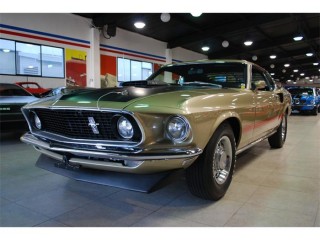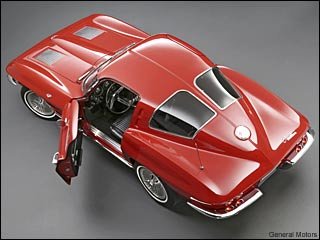
THOSE WERE THE DAYS, MY FRIEND, I THOUGHT THEY’D NEVER END
Like a lot of people that read our online publication, VT, I sometimes get tired of politicians, politics, draft dodgers, bureaucrats and, to borrow a term from General Norman Scharzkopf, the daily “bovine scatology” that our world produces.
I was reading our daily, local newspaper, the News-Enterprise out of Elizabethtown, Kentucky, and they had an insert about the 2011 model year automobiles that were now being sold and that set this old mind down memory lane.
For us Vietnam Veteran baby-boomers, remember when you could just look at a new car from the automobile capitol of the world in the 60’s and 70’s, Detroit, Michigan and tell what year it was by the styling? Do you remember the old black and white television commercials about the upcoming new year models and then seeing them in all their vivid colors on the street or in a showroom for the first time? WOW, the car seemed to have come to life seeing it up close and in color! How many of us dreamed and wished about getting our own car when we were old enough and could afford it?
Sting Ray
For me, one of my most vivid memories is as a 13 year old kid in New Smyrna Beach, Florida and laying eyes on a brand new 1963 Corvette Sting Ray, split window coupe, red as red could be, sitting in a showroom on the north end of the city.
I remember just staring at that car and vowing one day that I would own a Sting Ray when I became an adult. I did not realize that Vietnam would interrupt those dreams at that time but, I was bound and determined that one day I would have a Corvette Sting Ray.
The new body style of the 1963 Sting Ray was futuristic, yes, prior Corvettes had the bucket seats and tachometer but the 1963 Sting Ray dashboard and gauges were updated and it looked like the driver was sitting in the cockpit of an airplane. For the first time a hard top coupe was offered for a Corvette and the roadster was still available as a convertible with a removable hardtop, not to mention the knock off wheels where one took a rubber mallet to loosen the spinner to remove a tire instead of traditional lug nuts.
The memory of that red, 1963 Corvette Sting Ray coupe is as picturesque today for me as it was in 1962, 48 years ago.
Little GTO, You’re Really Lookin’ Fine
Three Deuces And A Four-Speed And A 389
Listen To Her Tachin’ Up Now, Listen To Her Why-ee-eye-ine
C’mon And Turn It On, Wind It Up, Blow It Out GTO
Many people give Pontiac the credit for starting the muscle car era with its new model the GTO which in reality was an option for its Tempest model. 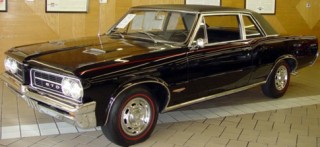 Pontiac would no longer be looked at as a stodgy, old person’s car as the GTO made its debut in 1964. With a 389 cubic inch engine and three, two barrel carburetors as one of the power options, the “GOAT” as it was sometimes called, was one mean street machine. The car was so popular that Ronnie and the Daytona’s, a one hit wonder surf rock band recorded a popular song that became a hit on the radio, Little GTO.
Pontiac would no longer be looked at as a stodgy, old person’s car as the GTO made its debut in 1964. With a 389 cubic inch engine and three, two barrel carburetors as one of the power options, the “GOAT” as it was sometimes called, was one mean street machine. The car was so popular that Ronnie and the Daytona’s, a one hit wonder surf rock band recorded a popular song that became a hit on the radio, Little GTO.
Pontiac used the tiger in TV commercials with the GTO to reflect the car’s power and agility and the GTO set the standard for the muscle car mania that was to follow GTO & Tiger Commercial For 1966. The GTO had a production run from 1964 to 1974 and was revived by Pontiac in 2004 until 2006 but like Pontiac, GTO became a part of automobile American history.
An iconic image of the muscle car era that started in mid 1964 and still is with us today is Ford’s venerable Mustang. I remember a young man in New Smyrna Beach, Florida that had a yellow, 1964 1/2 Mustang and it had a 260 ci engine. April 17, 1964 was the day Ford Motor Company introduced Americans to the Mustang at the World’s Fair in New York City and two days later many of us saw the new car on our black and white television sets when the big three networks, ABC, NBC and CBS aired commercials for Ford’s new car that would become a legend in automotive circles ( 1964 1/2 Ford Mustang Commercial).
When the Ford Mustang appeared in our living rooms on TV it was probably during commercial breaks for Bonanza and the Fugitive which parents might be watching and if your household was lucky enough to have two TV sets, the baby-boomers might have been watching Gomer Pyle, Bewitched or Combat. Now 46 years later the venerable Mustang is still with us, and although it has gone through many interior and exterior changes, it is still a car of beauty and power. Oil shortages, high gas prices and the invasion of foreign car manufactures have threatened its existence but the Pony car drives on.
A famous song for baby-boomers is the hit song, Mustang Sally, and the great soul singer and entertainer, Wilson “Wicked” Pickett, recorded the most famous version. Another rendition of the song was recorded and released the same year by one of my favorite groups from back then, The Rascals. During one of the Space Shuttle missions with astronaut Sally Ride onboard, NASA played the song for a morning wake-up call for her and the other crew members when they were orbiting earth.
NEW LIME GREEN MACH 1 FORD MUSTANG
1969 Ford Mustang Mach 1 TV Commericial
I knew a gentleman from my days in Kentucky before departing for South Vietnam, we became friends and he was a wonderful person.
I last saw him during my basic training at Fort Knox around March of 1968 when he came down to visit while going through his AIT (advance individual training) at Fort Knox. Before he left for Vietnam, this young man bought a 1969 New Lime Green, Mach 1, Ford Mustang and he was proud of his new car.
He would leave it at home with his family while he served his tour in Vietnam but in the mean time he was cruising in style. This young trooper gave his life for America in Vietnam, a non-hostile death as he was trying to save a South Vietnamese civilian and in the process lost his life.
In February of 1971 his body was returned to the United States, I went to his funeral. His “dream car” remained in the family for a long time but I do not know its status now. Whenever I hear the song by David Ball, “Riding With Private Malone”, I think of this kind hearted and selfless man that gave his all for another person and his country (David Ball, Riding With Private Malone), (Riding With Private Malone, Video 2).
Dreaming Of The World, Land Of The Big PX
I remember guys in my helicopter unit in Vietnam getting car magazines sent from home and we would check out the latest makes, models, colors and engine choices while drooling and thinking about cruising back in the States on a Friday or Saturday night.
It I am not mistaken, I think some guys actually purchased cars while in Vietnam and picked them up when they finished their tour of duty in the land of the little PX and returned home. We were the rock n roll generation and the muscle car era came when we, Vietnam Veteran, baby-boomers, had a pocket full of money after our tour of duty in a war zone and many of us were ready to let the good times roll, (or should I say cruise).
CHEAP GAS, BIG ENGINES, ROCK N ROLL AND CRUISING
We had cheap gas, engines that roared and a sound system that would be considered archaic today, AM radio, but we survived Vietnam and now we were back in the WORLD and ready to hit the streets with our rock n rolling blaring and our big Detroit engines roaring. Do your remember these great songs by the Beach Boys? 409 (1962), Shut Down (1963), Little Deuce Coupe (1963), Fun, Fun, Fun (1964). The Rip Chords, another surf/rock band like Ronnie and the Daytona’s who released Little GTO which I mentioned above, had a number of songs but are best remembered for the only song I can recall, Hey Little Cobra (1964).
There was a singing duo that had a number of hot rod hits too, Jan Berry and Dean Torrence who were called Jan and Dean. The duet released Drag City (1963), Dead Man’s Curve (1964) and Little Old Lady From Pasadena (1964). In 1978 a TV movie about Jan and Dean called, Dead Man’s Curve, was broadcast and it was the story of these two individuals and their rise to stardom, their decline and then later, somewhat of a comeback in the world of show business.
According to the movie and what I have found researching on the Internet, Jan Berry was upset that he had lost his final appeal with the draft board concerning his draft notice and being one to drive fast anyway and upset about possibly having to serve his country in the military and possibly having to go to Vietnam, he crashed into a parked truck at 80 mph in a 1966 Corvette Stingray and was in a coma for a month. It was a horrific crash which caused some permanent brain damage and partial paralysis for Berry.
I remember watching the made for television movie in 1978 and recall the scene where he went into the draft board angry and very condescending to the Army sergeant that was on duty at that time. If my memory serves me correctly, Jan Berry was shouting to the Army sergeant something about, “I am Jan Berry, part of the singing duo, Jan and Dean, you can’t draft me.” The Army sergeant replied, “We drafted Elvis and he was a lot bigger than you.”
As young men and women returning from South Vietnam, we sure had a lot of choices when it came to purchasing our “dream machine” which was an extension of our personalities and represented our personal preferences for the endless American made muscle that now emanated from Detroit, Michigan.
General Motors, Ford, Chrysler and American Motors all jumped on the bandwagon to produce American muscle cars in order to satisfy the insatiable appetite of the baby-boomer generation for automobiles that were unlike anything their parents had ever owned and driven.
GMC
General Motors Corporation started the craze of muscle cars with what many consider the first one out of the factory, the Pontiac GTO in 1964. The car was developed by Russell Gee, Bill Collins and John DeLorean. DeLorean later went on to start his own automobile company which produced the Delorean DMC-12, made famous in the movie “Back To The Future”.
The United States government later charged John DeLorean with trafficking in cocaine which DeLorean was acquitted on the grounds that the government had entrapped him. Pontiac also gave us the Firebird, it was produced from 1967 through 2002, it and its cousin, the Chevy Camaro, had similar styling. Arguably, the most famous Pontiac Firebird, which later evolved into the model called a Trans Am, was from the 1977 hit movie, Smokey And The Bandit. Of course, 1977 was well past the original muscle car era but even with all the anti-pollution technology for the time and the watered down horsepower, Burt Reynolds Trans Am had a lot of pep.
GMC also made the Chevy Chevelle, Camaro, El Camino and Corvette muscle, Oldsmobile brought us the tire screeching, big engine block rumble of the 442, Buick, the model that many people would never associate with American car muscle gave us the GS which is highly sought after today with a 400 Wildcat engine.
FORD
Henry Ford’s company gave us the Mustang in many versions with a lot of ponies under the hood and the car is literally a legend today. Who can forget the car chase scene in the 1968 film, Bullitt, starring Steve McQueen and his green 1968 Mustang. The Torino GT was another model that had a lot of “guts” under the hood and recently “went Hollywood” on us. Gran Torino was a 2008 film directed by and starring Clint Eastwood who played a Korean War Veteran whose hardcore exterior about people of Asian ancestry melted when he came to the aid of his Hmong (Laotian) neighbor that first tried to steal his car, a mint 1972 Ford Gran Torino.
The Fairlane GT also was impressive during the muscle car era and, in my opinion, was a nice looking automobile. Mercury, a subsidiary of Ford, gave us the Cougar which was an upscale version of the Mustang and the Cyclone CJ. Engines that rumbled even at idle with horsepower never envisioned previously in American cars, sleek styling with various colors and tires that would screech, all the automobile manufactures were putting out a product to capture the wallets and purses of the baby-boommers that were coming of age.
AMC
The smallest American auto manufacturer, American Motors, was late in producing muscle cars but when they finally did enter that arena, automobile enthusiasts credited the company with producing some impressive machines. The fastback Rambler Marlin was the first entry for American Motors into the muscle car market and continued with the Javelin, Rambler/AMC Rebel and the shortened version of the Javelin, the AMX.
The Rebel also was produced in a version called, The Machine, pained with red, white and blue reflective stripes. When The Machine was introduced in 1970, only 2,326 cars were produced. Yes, even little AMC with its Rambler namesake was entering the muscle car market with impressive results.
MOPAR
Any article about the muscle car era would be incomplete if MOPAR was not included. MOPAR, a word derived from Chrysler, Dodge and Plymouth dealership’s service department’s, motor parts, produced the HEMI engine and some of the fastest and most coveted muscle cars at that time. Dodge gave us the Challenger, Charger and Demon while Plymouth gave us the Barracuda, Road Runner and the ultra rare Superbird. So many different models to choose from with engines that roared and some colors that could burn your retina’s and returning Vietnam Veterans and other baby boomers were laying down their money as fast as they could to own and drive one of those dream machines.
It was a great time to come of age if one wanted to make a statement about themselves with a particular make and model of a car that really had muscle, but sadly 58,000 plus names on the Vietnam Veteran’s Memorial never got that chance and if they did, it was shortened when they made the ultimate sacrifice for their country.
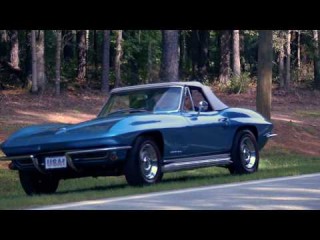 I was very lucky to have survived Vietnam and I did realize my dream of owning a Corvette Sting Ray. In May of 1970 while home on leave, I purchased a 1967 Corvette Stingray Roadster, Marina Blue with white interior, with both tops and a 327 ci motor with 350 horses under the hood for $2850.
I was very lucky to have survived Vietnam and I did realize my dream of owning a Corvette Sting Ray. In May of 1970 while home on leave, I purchased a 1967 Corvette Stingray Roadster, Marina Blue with white interior, with both tops and a 327 ci motor with 350 horses under the hood for $2850.
Yes, $2850 and in this day and age and what Corvettes and other muscle cars are fetching it was quite a bargain. I purchased it from Chizek Corvette in Cleveland, Ohio and the guy had two lots just full of the mid-year Sting Rays, Corvettes from 1959 to 1962 and the newer Stingrays from 1968 to 1970.
If I omitted any car in my article, I can assure the reader it was not intentional. I just wanted to share my thoughts on my youth and the muscle car era and if anyone has a similar story please respond in the comment area of the article as I would very much enjoy your personal story of coming home from Vietnam and your experience with your dream automobile.
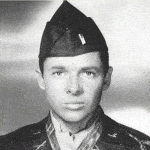
Joe is a Vietnam Combat Veteran, having served 26 months in the Republic Of South Vietnam, 10 months with Company A, 27th Combat Engineers, 28 August 1968 to June 1969, and 16 months as a crewchief/doorgunner with the 240th Assault Helicopter company on UH-1C Hueys, the Mad Dog Gunship Platoon from July 1969 to 22 October 1970.
Joe graduated from Cuyahoga Community College in 1982 with a Associate Of Arts Degree and from Cleveland State University in 1986 with a Bachelor’s Degree in Psychology; he also accumulated 12 hours of graduate work at Cleveland State. He lives with his best friend, his wife, and they have 34 rescued cats, 7 rescued dogs.
Joe has spoken at high schools and colleges for 25 years about PTSD, war and how not to treat returning veterans when they come home to America after fighting for their country.
ATTENTION READERS
We See The World From All Sides and Want YOU To Be Fully InformedIn fact, intentional disinformation is a disgraceful scourge in media today. So to assuage any possible errant incorrect information posted herein, we strongly encourage you to seek corroboration from other non-VT sources before forming an educated opinion.
About VT - Policies & Disclosures - Comment Policy

